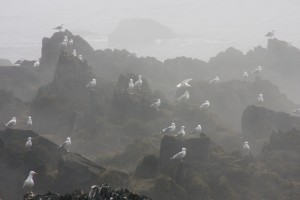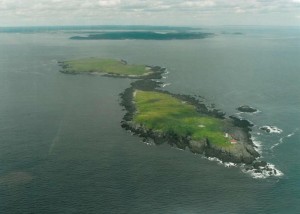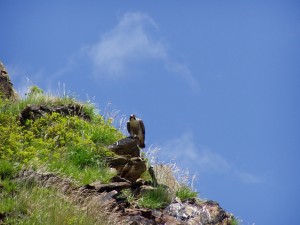June 18, 2015 at 8:26 am
Wildlife Division Director Judy Camuso joined Region C Wildlife Biologists last week on an offshore run out to Big Libby Island to gain, in part, some familiarity with the island, generally assess seabird use, and attempt to document the presence/absence of peregrine falcons due to a proposal for nearby, offshore development. Lingering fog banks and sea swells made the first half of the day less than ideal, but tight schedules dictated that we persevere (and return none the worse for wear) to report our findings.
[caption id="attachment_728" align="aligncenter" width="332"] Some of Big Libby Island ledges in the fog with resident gulls[/caption]
Big Libby Island is part of the Department’s Coast of Maine Wildlife Management Area which consists of over 300 islands and ledges which have significant values to coastal wildlife resources. Some of these sites are fee-owned by the Department; others are owned by other agencies such as the Bureau of Parks and Lands in the Department of Agriculture, Conservation and Forestry who have transferred management authority to us.
Big Libby Island is a 95-acre barrier island surrounded by an additional 60 acres of intertidal habitat that lies approximately 5 miles offshore from the nearest port in Bucks Harbor. Its remoteness, size, open water environs, and position within the Gulf of Maine contribute to its biological values and attraction to seabirds (and other wildlife) by being relatively isolated from predators and human disturbance. The island is vegetated with dense, low-growth herbaceous and ericaceous shrubs making it ideal for a variety of colonial nesting seabirds, other waterfowl, and even some terrestrial songbird species.
[caption id="attachment_729" align="alignright" width="300"]
Some of Big Libby Island ledges in the fog with resident gulls[/caption]
Big Libby Island is part of the Department’s Coast of Maine Wildlife Management Area which consists of over 300 islands and ledges which have significant values to coastal wildlife resources. Some of these sites are fee-owned by the Department; others are owned by other agencies such as the Bureau of Parks and Lands in the Department of Agriculture, Conservation and Forestry who have transferred management authority to us.
Big Libby Island is a 95-acre barrier island surrounded by an additional 60 acres of intertidal habitat that lies approximately 5 miles offshore from the nearest port in Bucks Harbor. Its remoteness, size, open water environs, and position within the Gulf of Maine contribute to its biological values and attraction to seabirds (and other wildlife) by being relatively isolated from predators and human disturbance. The island is vegetated with dense, low-growth herbaceous and ericaceous shrubs making it ideal for a variety of colonial nesting seabirds, other waterfowl, and even some terrestrial songbird species.
[caption id="attachment_729" align="alignright" width="300"] The Libby Islands with Little Libby in foreground (USF&WS) and Big Libby Island (MDIF&W) immediately behind[/caption]
In the late 1980’s, the Department assessed our interest in the future of Big Libby Island when it became apparent that the island was destined to go on the market. MDIF&W wildlife biologists involved with coastal wildlife resource inventories at the time characterized the island as “one of the most important seabird nesting islands on the coast of Maine” and recommended permanent protection through fee acquisition. Nesting surveys during this period indicated approximately 1,500 nesting common eider sea ducks in addition to 2,000 other colonial nesting seabirds.
In April of 1991, the Department invested State-generated funds through the Maine Duck Stamp program to purchase Big Libby Island to assure permanent habitat protection. While nesting populations and species compositions have fluctuated over the years, the island remains as one of the top ten most important nesting islands in the State because of its habitat contributions according to an assessment by the Department’s Bird Group.
In November of 1999, the U.S. Fish & Wildlife Service acquired Little Libby Island which is adjacent and conjoined to Big Libby by a rocky, intertidal ledge. Our two agencies have collaborated on census and management efforts on both these islands as well as many other nesting islands under individual agency ownership or management authority.
[caption id="attachment_731" align="alignleft" width="300"]
The Libby Islands with Little Libby in foreground (USF&WS) and Big Libby Island (MDIF&W) immediately behind[/caption]
In the late 1980’s, the Department assessed our interest in the future of Big Libby Island when it became apparent that the island was destined to go on the market. MDIF&W wildlife biologists involved with coastal wildlife resource inventories at the time characterized the island as “one of the most important seabird nesting islands on the coast of Maine” and recommended permanent protection through fee acquisition. Nesting surveys during this period indicated approximately 1,500 nesting common eider sea ducks in addition to 2,000 other colonial nesting seabirds.
In April of 1991, the Department invested State-generated funds through the Maine Duck Stamp program to purchase Big Libby Island to assure permanent habitat protection. While nesting populations and species compositions have fluctuated over the years, the island remains as one of the top ten most important nesting islands in the State because of its habitat contributions according to an assessment by the Department’s Bird Group.
In November of 1999, the U.S. Fish & Wildlife Service acquired Little Libby Island which is adjacent and conjoined to Big Libby by a rocky, intertidal ledge. Our two agencies have collaborated on census and management efforts on both these islands as well as many other nesting islands under individual agency ownership or management authority.
[caption id="attachment_731" align="alignleft" width="300"] Adult peregrine falcon perched on Big Libby Island in 2006 (USFWS photo)[/caption]
Fifteen years after its acquisition, Big Libby Island became home to a nesting pair of peregrine falcons (State endangered) and successfully fledged 3 chicks. This was a notable discovery in that peregrine falcons nesting on an offshore coastal island had not been documented for many years. Monitoring efforts for continued residence and nesting attempts/success has been limited due to logistical challenges, so it was important to make an assessment this year. Happily, as we approached the island, Judy and Region C Wildlife Biologist Sarah Spencer were able to identify an adult peregrine just before it disappeared over the top of a cliff. There was also a strong indication of nesting effort, although reproduction could not be confirmed at the time.
Within minutes of observing the falcon, another one of a kind observation was made on this un-forested, remote, barrier island when a doe deer appeared and briefly peered down at us from on top of the cliffs before running off. To where, we’re not quite sure.
It should be noted that most of the islands under the Coast of Maine WMA, are seasonally closed to public access depending on resident species. On Big Libby, the island is closed to visitation from April 15 through August 31 annually.
Adult peregrine falcon perched on Big Libby Island in 2006 (USFWS photo)[/caption]
Fifteen years after its acquisition, Big Libby Island became home to a nesting pair of peregrine falcons (State endangered) and successfully fledged 3 chicks. This was a notable discovery in that peregrine falcons nesting on an offshore coastal island had not been documented for many years. Monitoring efforts for continued residence and nesting attempts/success has been limited due to logistical challenges, so it was important to make an assessment this year. Happily, as we approached the island, Judy and Region C Wildlife Biologist Sarah Spencer were able to identify an adult peregrine just before it disappeared over the top of a cliff. There was also a strong indication of nesting effort, although reproduction could not be confirmed at the time.
Within minutes of observing the falcon, another one of a kind observation was made on this un-forested, remote, barrier island when a doe deer appeared and briefly peered down at us from on top of the cliffs before running off. To where, we’re not quite sure.
It should be noted that most of the islands under the Coast of Maine WMA, are seasonally closed to public access depending on resident species. On Big Libby, the island is closed to visitation from April 15 through August 31 annually.
 Some of Big Libby Island ledges in the fog with resident gulls[/caption]
Big Libby Island is part of the Department’s Coast of Maine Wildlife Management Area which consists of over 300 islands and ledges which have significant values to coastal wildlife resources. Some of these sites are fee-owned by the Department; others are owned by other agencies such as the Bureau of Parks and Lands in the Department of Agriculture, Conservation and Forestry who have transferred management authority to us.
Big Libby Island is a 95-acre barrier island surrounded by an additional 60 acres of intertidal habitat that lies approximately 5 miles offshore from the nearest port in Bucks Harbor. Its remoteness, size, open water environs, and position within the Gulf of Maine contribute to its biological values and attraction to seabirds (and other wildlife) by being relatively isolated from predators and human disturbance. The island is vegetated with dense, low-growth herbaceous and ericaceous shrubs making it ideal for a variety of colonial nesting seabirds, other waterfowl, and even some terrestrial songbird species.
[caption id="attachment_729" align="alignright" width="300"]
Some of Big Libby Island ledges in the fog with resident gulls[/caption]
Big Libby Island is part of the Department’s Coast of Maine Wildlife Management Area which consists of over 300 islands and ledges which have significant values to coastal wildlife resources. Some of these sites are fee-owned by the Department; others are owned by other agencies such as the Bureau of Parks and Lands in the Department of Agriculture, Conservation and Forestry who have transferred management authority to us.
Big Libby Island is a 95-acre barrier island surrounded by an additional 60 acres of intertidal habitat that lies approximately 5 miles offshore from the nearest port in Bucks Harbor. Its remoteness, size, open water environs, and position within the Gulf of Maine contribute to its biological values and attraction to seabirds (and other wildlife) by being relatively isolated from predators and human disturbance. The island is vegetated with dense, low-growth herbaceous and ericaceous shrubs making it ideal for a variety of colonial nesting seabirds, other waterfowl, and even some terrestrial songbird species.
[caption id="attachment_729" align="alignright" width="300"] The Libby Islands with Little Libby in foreground (USF&WS) and Big Libby Island (MDIF&W) immediately behind[/caption]
In the late 1980’s, the Department assessed our interest in the future of Big Libby Island when it became apparent that the island was destined to go on the market. MDIF&W wildlife biologists involved with coastal wildlife resource inventories at the time characterized the island as “one of the most important seabird nesting islands on the coast of Maine” and recommended permanent protection through fee acquisition. Nesting surveys during this period indicated approximately 1,500 nesting common eider sea ducks in addition to 2,000 other colonial nesting seabirds.
In April of 1991, the Department invested State-generated funds through the Maine Duck Stamp program to purchase Big Libby Island to assure permanent habitat protection. While nesting populations and species compositions have fluctuated over the years, the island remains as one of the top ten most important nesting islands in the State because of its habitat contributions according to an assessment by the Department’s Bird Group.
In November of 1999, the U.S. Fish & Wildlife Service acquired Little Libby Island which is adjacent and conjoined to Big Libby by a rocky, intertidal ledge. Our two agencies have collaborated on census and management efforts on both these islands as well as many other nesting islands under individual agency ownership or management authority.
[caption id="attachment_731" align="alignleft" width="300"]
The Libby Islands with Little Libby in foreground (USF&WS) and Big Libby Island (MDIF&W) immediately behind[/caption]
In the late 1980’s, the Department assessed our interest in the future of Big Libby Island when it became apparent that the island was destined to go on the market. MDIF&W wildlife biologists involved with coastal wildlife resource inventories at the time characterized the island as “one of the most important seabird nesting islands on the coast of Maine” and recommended permanent protection through fee acquisition. Nesting surveys during this period indicated approximately 1,500 nesting common eider sea ducks in addition to 2,000 other colonial nesting seabirds.
In April of 1991, the Department invested State-generated funds through the Maine Duck Stamp program to purchase Big Libby Island to assure permanent habitat protection. While nesting populations and species compositions have fluctuated over the years, the island remains as one of the top ten most important nesting islands in the State because of its habitat contributions according to an assessment by the Department’s Bird Group.
In November of 1999, the U.S. Fish & Wildlife Service acquired Little Libby Island which is adjacent and conjoined to Big Libby by a rocky, intertidal ledge. Our two agencies have collaborated on census and management efforts on both these islands as well as many other nesting islands under individual agency ownership or management authority.
[caption id="attachment_731" align="alignleft" width="300"] Adult peregrine falcon perched on Big Libby Island in 2006 (USFWS photo)[/caption]
Fifteen years after its acquisition, Big Libby Island became home to a nesting pair of peregrine falcons (State endangered) and successfully fledged 3 chicks. This was a notable discovery in that peregrine falcons nesting on an offshore coastal island had not been documented for many years. Monitoring efforts for continued residence and nesting attempts/success has been limited due to logistical challenges, so it was important to make an assessment this year. Happily, as we approached the island, Judy and Region C Wildlife Biologist Sarah Spencer were able to identify an adult peregrine just before it disappeared over the top of a cliff. There was also a strong indication of nesting effort, although reproduction could not be confirmed at the time.
Within minutes of observing the falcon, another one of a kind observation was made on this un-forested, remote, barrier island when a doe deer appeared and briefly peered down at us from on top of the cliffs before running off. To where, we’re not quite sure.
It should be noted that most of the islands under the Coast of Maine WMA, are seasonally closed to public access depending on resident species. On Big Libby, the island is closed to visitation from April 15 through August 31 annually.
Adult peregrine falcon perched on Big Libby Island in 2006 (USFWS photo)[/caption]
Fifteen years after its acquisition, Big Libby Island became home to a nesting pair of peregrine falcons (State endangered) and successfully fledged 3 chicks. This was a notable discovery in that peregrine falcons nesting on an offshore coastal island had not been documented for many years. Monitoring efforts for continued residence and nesting attempts/success has been limited due to logistical challenges, so it was important to make an assessment this year. Happily, as we approached the island, Judy and Region C Wildlife Biologist Sarah Spencer were able to identify an adult peregrine just before it disappeared over the top of a cliff. There was also a strong indication of nesting effort, although reproduction could not be confirmed at the time.
Within minutes of observing the falcon, another one of a kind observation was made on this un-forested, remote, barrier island when a doe deer appeared and briefly peered down at us from on top of the cliffs before running off. To where, we’re not quite sure.
It should be noted that most of the islands under the Coast of Maine WMA, are seasonally closed to public access depending on resident species. On Big Libby, the island is closed to visitation from April 15 through August 31 annually.Categories